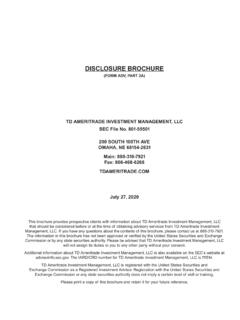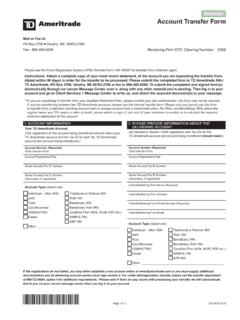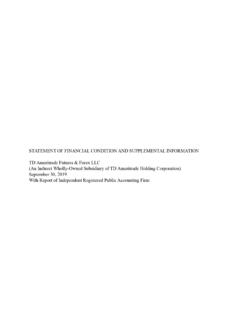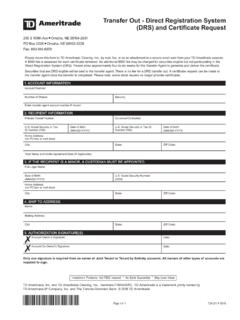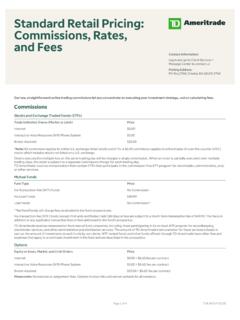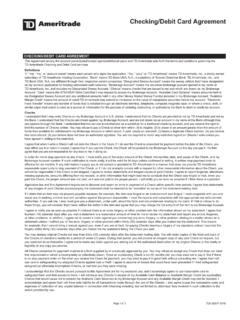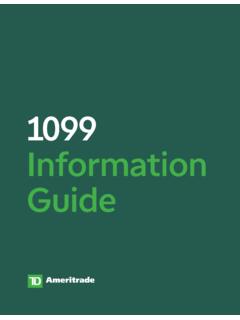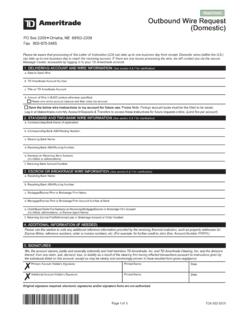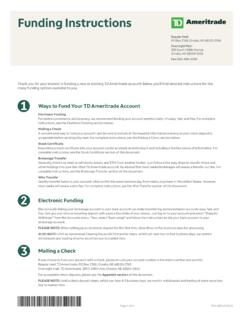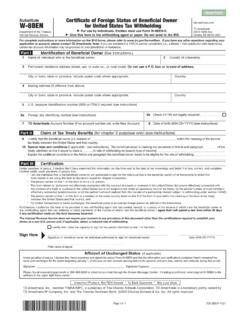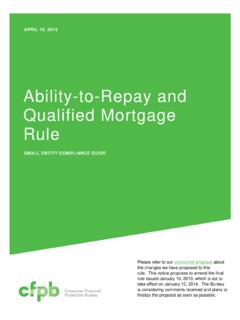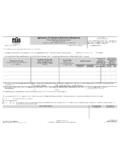Transcription of Margin Handbook-AMTD 1221 - TD Ameritrade
1 Margin HandbookMargin can be an important part of your investment strategy. The Margin Handbook is designed to help you understand what Margin accounts are and how they work. For specific questions about your Margin account, we encourage you to contact a Client Services representative. *AMTD086*Table of Contents1. What Is Margin ? ..32. How Does Margin Work? ..43. Primary Uses, Advantages, and Disadvantages ..54. Responsibilities of Trading on Margin ..55. Margin Requirements ..66. Day Trading Margin Requirements ..77. Margin Calls.
2 88. Portfolio Margin ..99. Initial Public Offerings ..1010. Selling Stock ..1011. Withdrawals ..1112. Substitutions ..1113. Short Selling ..1214. Bonds and Debt Securities ..1315. Options ..1316. Buying Equity Options ..1417. Equity Spreads ..1618. Equity Straddles ..1719. Index Options ..1820. Options Exercise and Assignment ..2021. Substitute Payments ..2022. Margin Impact on Voting Rights ..2123. Glossary ..22 Page 2 of 26 AMTD 086 05/22 Page 3 of 26 AMTD 086 05/22 What Is Margin ?A Margin account permits investors to borrow funds from their brokerage firm to purchase marginable securities on credit and to borrow against marginable securities already in the account.
3 The terms of a Margin loan require that the qualifying securities or cash that you have in your account be used as collateral to secure the loan. Interest is charged on the borrowed funds for the period of time that the loan is outstanding. Both the amount of money that a brokerage firm may loan an investor and the terms of the loan agreement are subject to change and regulated by the following: the Board of Governors of the Federal Reserve System, the Securities and Exchange Commission (SEC), the Financial Industry Regulatory Authority, Inc.
4 (FINRA), and our clearing firm, TD Ameritrade Clearing, opening a Margin account must make a deposit of cash or eligible securities totaling at least $2,000 in equity. This serves as collateral for the loan. Thereafter, based upon Regulation T promulgated by the Federal Reserve Board, which is currently 50%, you can double the amount you invest in qualified securities as long as you maintain the minimum value in your account and conduct all trades within your Margin account. As an example, if you were buying $10,000 worth of marginable securities, you could make the purchase using $5,000 of your money and $5,000 of your brokerage firm s money.
5 Investors who buy on Margin pay interest on the loan portion of their purchase (in this example, $5,000), but normally do not have to repay the loan itself until the stock is sold. After repaying the Margin loan, any profit or loss belongs to the individual the value of the marginable securities in your account serves as collateral for the loan, Margin accounts require that your equity meet or exceed certain minimum levels. If it should drop too low, your brokerage firm will ask you to increase the value of your account by trading assets held in your portfolio, such as selling securities, buying to cover short positions, or closing options positions.
6 Or you may deposit marginable securities or cash into the account. This maintenance of minimum value will be described in greater detail in the sections that that can be purchased on Margin or used as collateral for a Margin account include: Most securities listed on the New York Stock Exchange (NYSE) The majority of NASDAQ/AMEX securities Most mutual funds, after you have owned them for 30 days or more Over-the-counter stocks approved by the Federal Reserve Board Certain corporate, municipal, and government bondsThere are several accounts ineligible for Margin privileges, including the following: Coverdell Accounts Minor Individual Retirement Account (IRA) Uniform Gifts to Minors Act (UGMA) Uniform Transfers to Minors Act (UTMA)PLEASE NOTE.
7 An Individual Retirement Account or Qualified Plan Account approved for Margin : Will not be permitted to borrow funds Will not have the ability to have a debit balance May not short stock or sell uncovered optionsCarefully review the Margin Disclosure Document for additional on Margin may not be appropriate for every investor. An investment strategy that includes trading on Margin exposes investors to additional costs, increased risks, and potential losses in excess of the amount deposited. Carefully review your investment objectives, financial resources, and risk tolerance to determine whether it is right for you.
8 No one should buy on Margin without the temperament to accept the price fluctuations that are intrinsic to the marketplace, and the financial resources to meet Margin calls and absorb trading losses. Please review the Client Agreement pertaining to Margin Equity equals marginable stock minus Margin Please refer to your Client Agreement for more Does Margin Work?When you buy securities on Margin , you pay only a portion of the total cost, and a brokerage firm extends credit to you on the balance. An interest charge is made monthly to your account on the amount you borrow.
9 From then on, the price of your security may go up or down, but the amount you owe your brokerage firm should remain relatively unchanged, varying only with the interest following is based upon current Regulation T requirements of 50%, and is an example of how the leverage in a Margin account works: You open a Margin account with $10,000 of your money and a $10,000 Margin loan from your brokerage firm. You purchase 1,000 shares of a marginable stock at $20 per share. If the stock price rises to $25 and you decide to sell, the proceeds amount to $25,000.
10 You repay the $10,000 you borrowed and put $15,000 in your pocket (minus interest, commissions and Regulatory fees). That s a net profit of $5,000 almost a 50% profit on your original investment. If you had used all of your own money and purchased $10,000 worth of stock, you would have made a 25% profit a $2,500 return on a $10,000 investment. Following the same example, let s assume that the stock priced originally at $20 a share should go down 25% to $15 a share, and you sell the stock to cut your losses. The proceeds would be $15,000.
